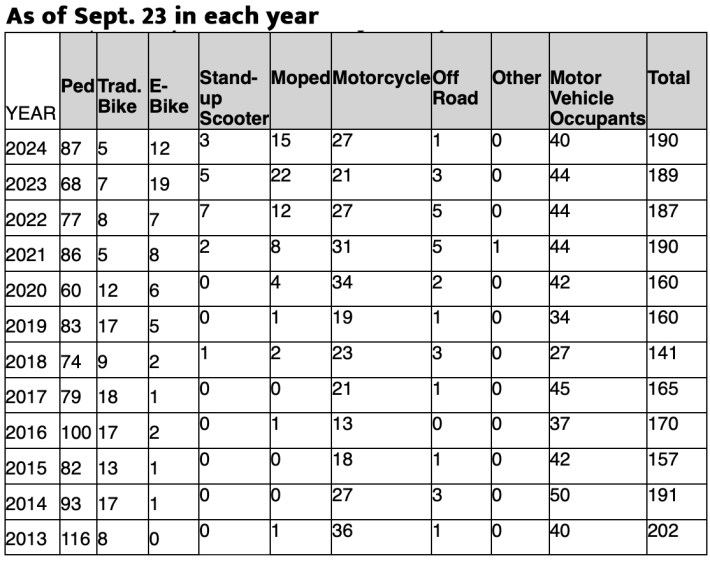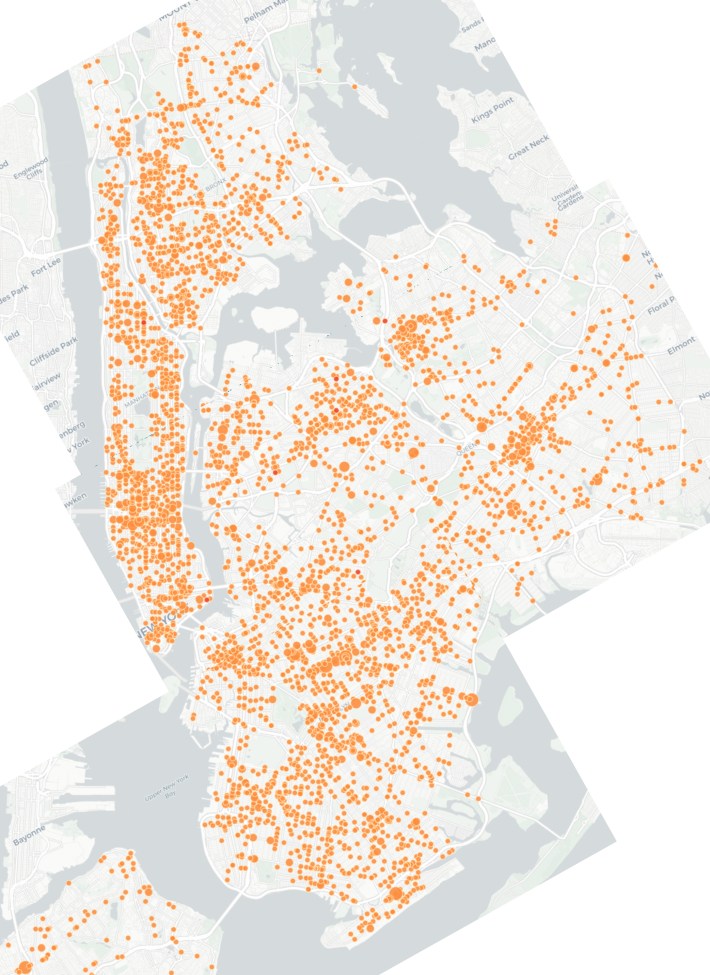What's driving the pedestrian fatality crisis? Well, driving.
The city's 2024 rise in pedestrian deaths continues, with the latest statistics from both the NYPD and the Department of Transportation showing a double-digit increase this year in killings of people walking on city streets — amid a rise in driving that is also in the double digits.
Between Jan. 1 and Sept. 23, 87 pedestrians were killed, up from 68 in the same period last year — an increase of 28 percent. The DOT was quick to point out that the 68 people who were killed last year was the lowest of any similar period (except for the pandemic), and cautioned against reading too much into partial-year statistics because of seasonal fluctuations.
That said, the 87 people killed so far this year is also higher than the average number of pedestrian fatalities during the Vision Zero years, 2014 to date. That increase is 8.5 percent above the average through this point in the year. And the NYPD reports that pedestrian injuries are up 4.4 percent so far this year, with 23 pedestrians injured every day on average.

"The erosion of street safety in the city is shocking," said Jon Orcutt, who worked for DOT under Mayor Mike Bloomberg and is now advocacy director for Bike New York. "We need to reestablish respect for basic rules of the road, and targeted enforcement needs to be part of how we do that. This should focus on the greatest danger — drivers, especially those trying to escape accountability with masked plates or no license."
The DOT also pointed out that New York's pedestrian fatality numbers are generally trending down from their historic highs before Vision Zero even as pedestrian deaths nationally have soared. And the Adams administration is in the middle of several key safety initiatives, including building more pedestrian plazas and safety islands, and daylighting 1,000 intersections per year.

So what's causing the problems?
There is a mistaken perception that pedestrian deaths and injuries are on the rise due to the increase in the use of motorized micromobility devices such as e-bkes and mopeds. And the NYPD has stepped up its enforcement against such devices. But the facts point to a much larger culprit: cars, trucks and other massive vehicles with four wheels or more.
According to the NYPD, through Sept. 21, the number of pedestrians who have been injured in crashes by riders of motorized scooters, mopeds and the 19 other categories by which cops identify vehicles is 354, or roughly 5.5 percent of the 6,378 pedestrians who have been injured in crashes involving all vehicles.
Last year over the same period, the number of pedestrians who were injured by the riders of motorized scooters, mopeds and the 19 other categories by which cops identify vehicles in crashes was 334, or roughly 5.4 percent of the 6,121 pedestrians who have been injured in crashes involving all vehicles.
And the year before, the number of pedestrians injured was also roughly 5.1 percent of pedestrians injured in all crashes.
Here's what that looks like in a chart:
Fatalities offer slightly different numbers, albeit too low to be statistically significant.
The number of pedestrians who have been killed by riders of motorized micromobility so far this year is three, or roughly 3.7 percent of the 81 pedestrians who have been killed in crashes involving all vehicles (including one killed by a conventional cyclist).
Last year over the same period, the number of pedestrians who were killed by riders of motorized micromobility was 1, or roughly 1.4 percent of the 68 pedestrians who were killed in crashes involving all vehicles.
In a statement, DOT said it is focusing on all vehicles — by both working with the NYPD to crack down on illegal mopeds, while also widening bike lanes to better accommodate legal e-bikes and e-scooters. Such designs, the agency says, will encourage more bike and e-bike riders to stay in bike lanes, which will make streets more predictable for pedestrians.
But the agency has identified the major culprit on our streets:
"Cars are heavier and faster and still pose a far greater risk to New Yorkers," agency spokesman Vin Barone said in a statement. "And that is why so much of our work has focused on rooting out reckless driving behavior. Since 2010, there have been 23 pedestrian fatalities involving bikes/e-bikes/stand-up scooters/mopeds, or about 1.2 percent of all pedestrian fatalities in that time period."
What's more, total miles driven in the New York metro region has increased by 14 percent since the pandemic, according to a new study. More driving has proven to result in more injuries and fatalities.






